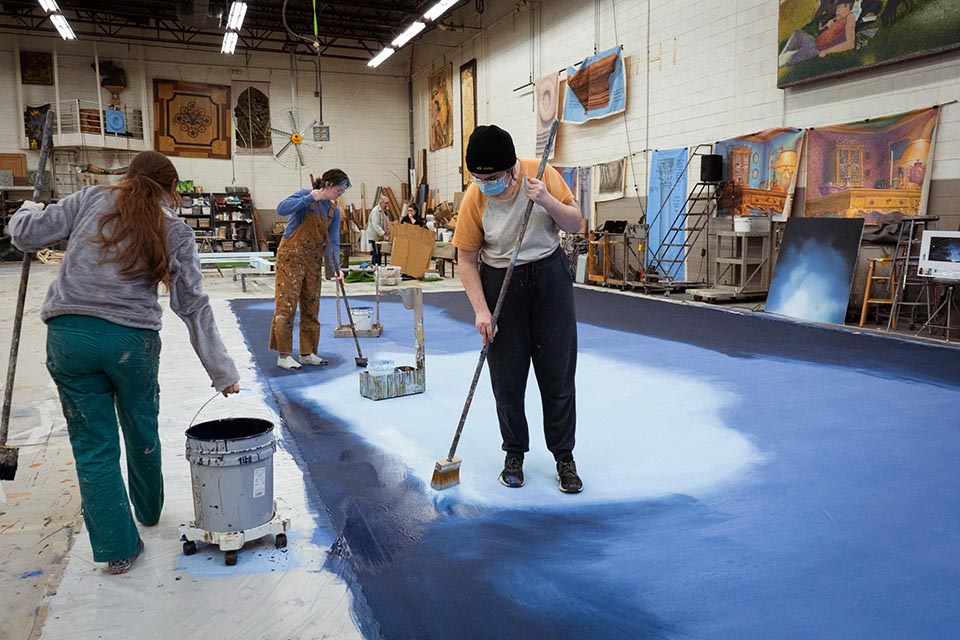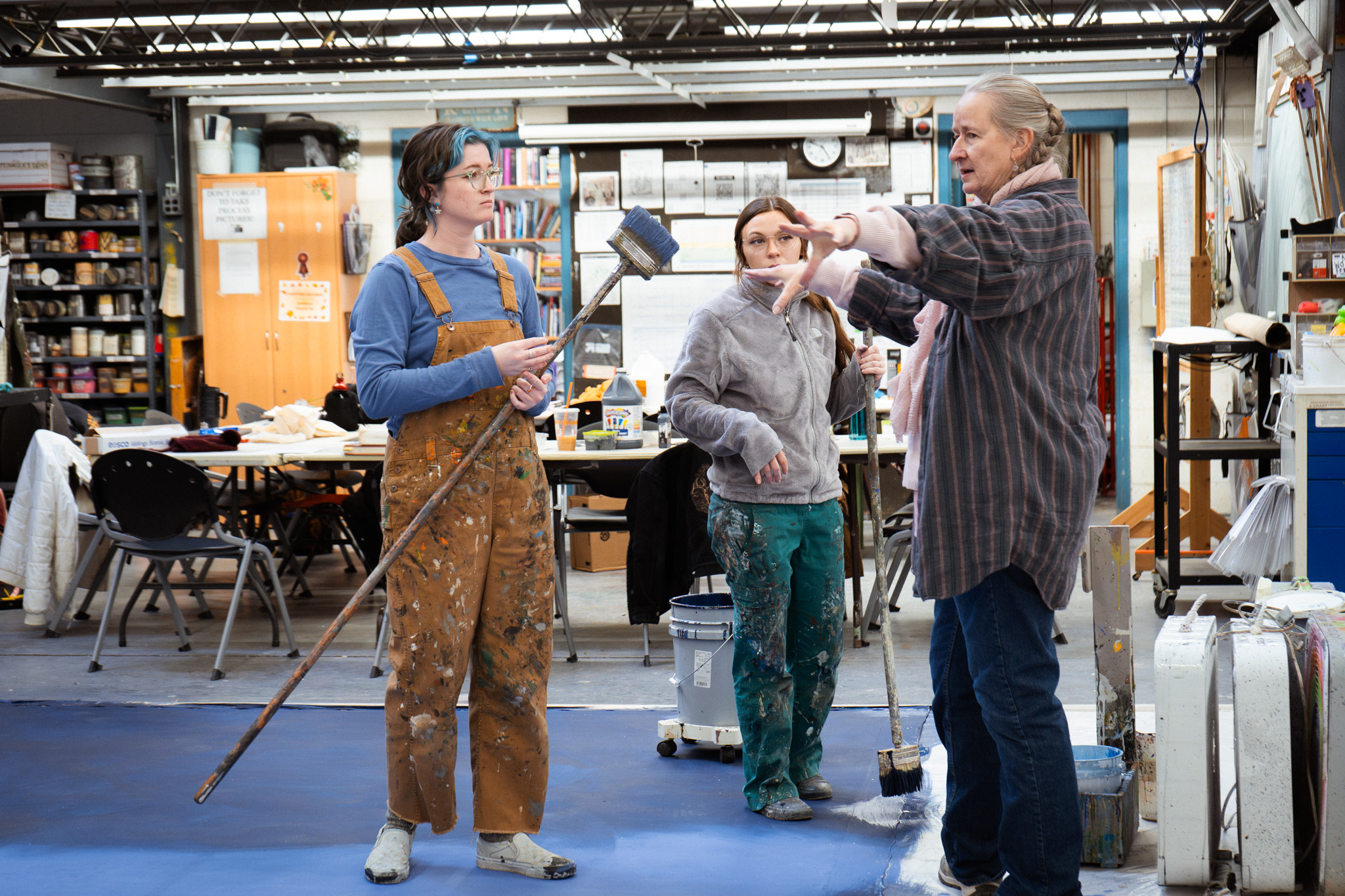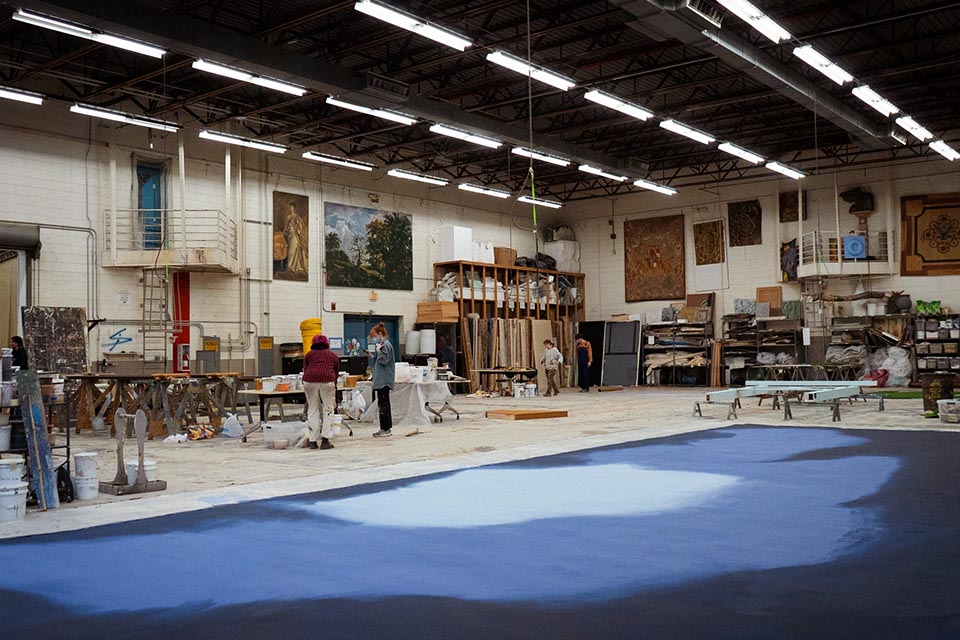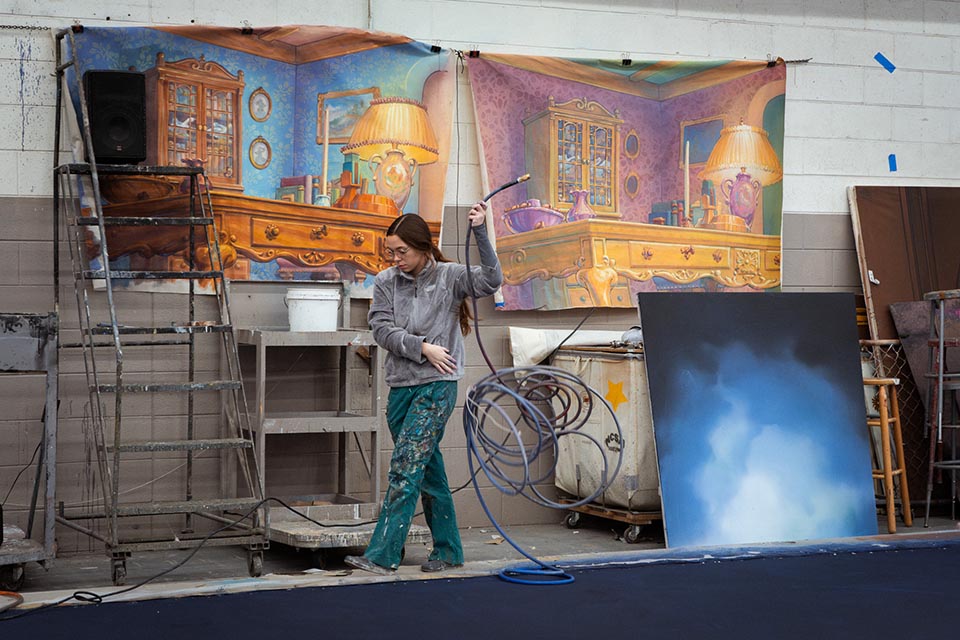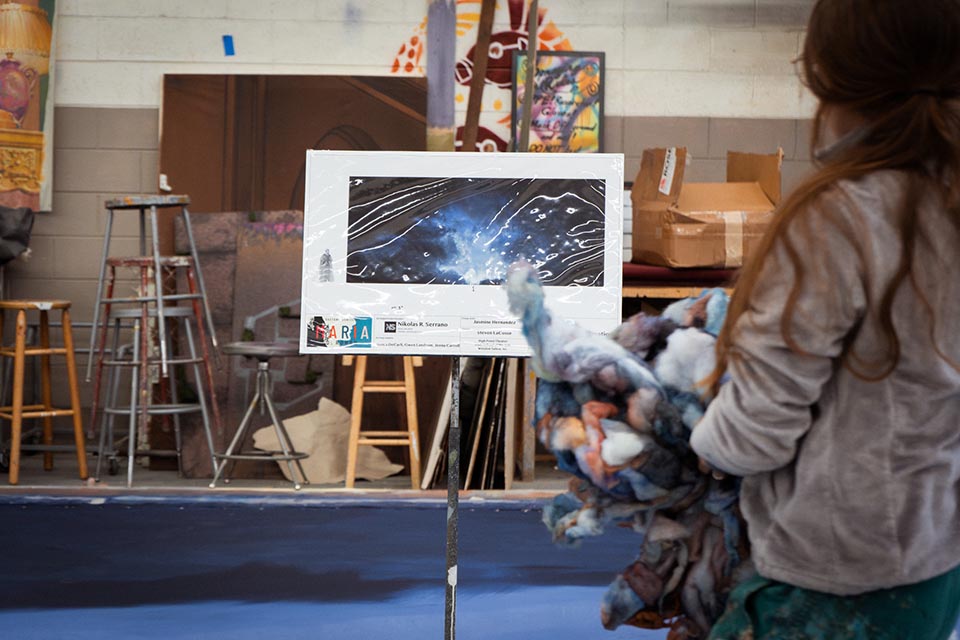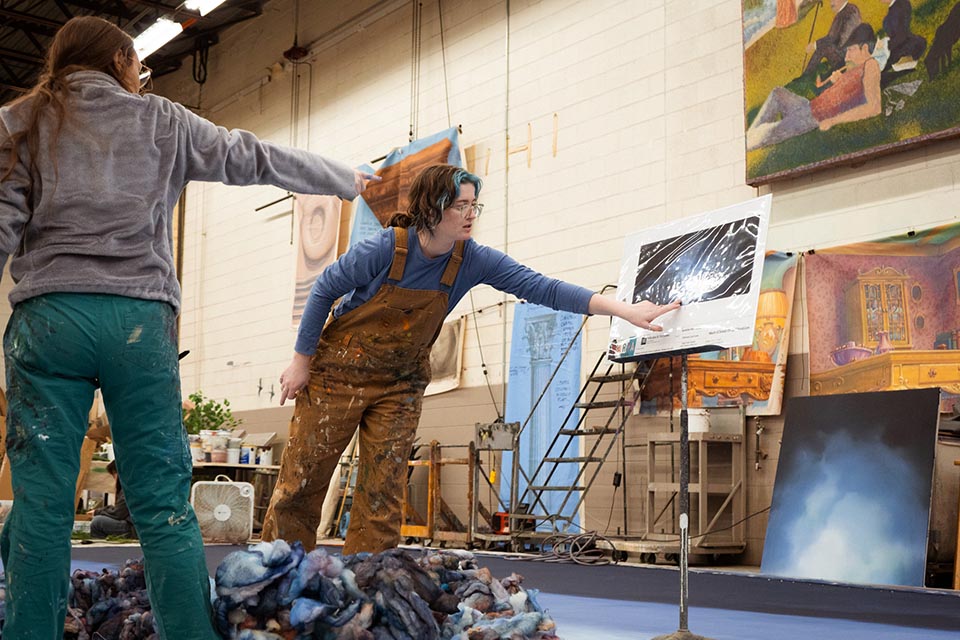Painting dreams: Susan Crabtree's pivotal role in Scenic Art education
As a child, Susan Crabtree never dreamed that her passion for art would turn into a lifetime career. However, since discovering scenic art in college, Crabtree has gone on to scene design and paint for numerous performing arts organizations, co-author the most trusted resource book for her craft, and eventually land in the School of Design and Production.
As director of the Scenic Art and Scene Painting programs, she gets to lead the oldest accredited scenic art program in the country, a position that she calls “her dream job.”
Through recruiting and referrals, Crabtree and her colleague alumna Rebecca Pancoast (M.F.A. Design & Production ‘05) have doubled the program in a handful of years and provide crucial support for many shows in production – often three at a time in the paint shop.
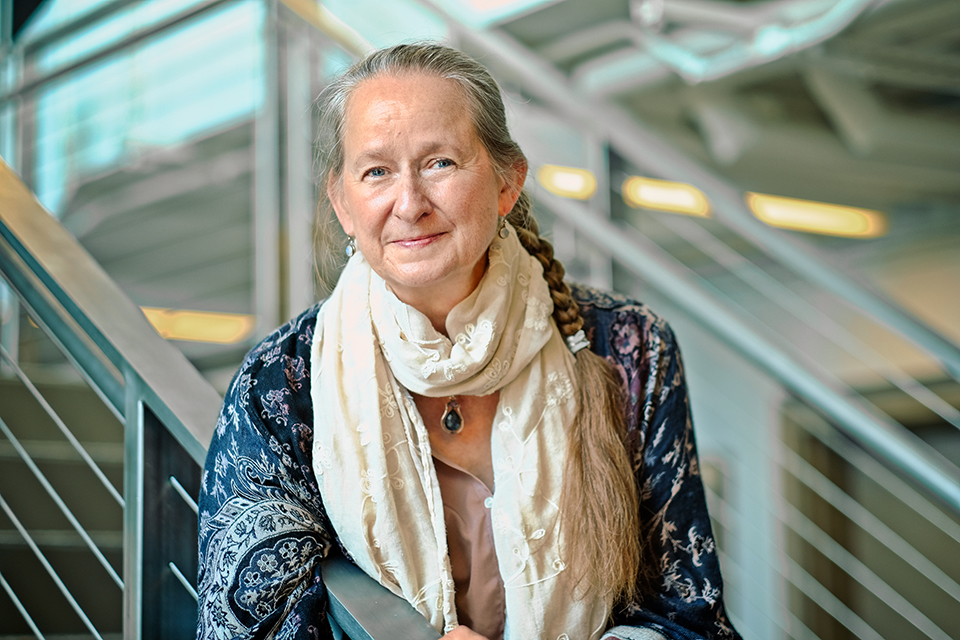
Director of Scenic Art and Scene Painting programs in the School of Design & Production Susan Crabtree.
Crabtree’s goal is not only to teach her students but also to grow general awareness of what scenic art is and how it fits into the overall design of scenery. “When people go to the theater, they know there are lighting, costume and scenic designers. They probably even know there are cobblers and stitchers and haberdashers. They don’t know there are scenic artists. They don’t realize this is a profession.”
The intersection of scene design and scenic artistry
The core of the scene painting and scenic art programs is collaboration – and it all starts with scene design. Crabtree explains how scene design merges with scenic artistry to create a landscape that transports audiences. The scene designer’s job is to develop the sculptural environment on stage, conveying fundamental information to the audience about such things as time period or economic status. But beyond that, “it is the sculptural manifestation of the work for that audience at that time in that space,” she says.
The designer creates a set of documents to communicate in specific, discreet and accurate ways to the different shops what their vision is so that it can be built full scale. At UNCSA, these shops include the Scene Shop, which houses students from Technical Direction and Scenic Technology; the Prop Shop, which houses students from Stage Properties; the Electrics Shop, which houses students from Lighting; and the Paint Shop, which houses students from Scene Painting and Scenic Art. “Artists/artisans must work together to complete the designer’s vision in shape, texture and color,” she explains.
“That is where scenic artistry gets really interesting and that is the hardest part to teach. How do you collaborate and communicate with the designer? How do you sync up with them? That is the fun part,” she adds. “That is what we teach, and it is what makes UNCSA so special. We are not just teaching artisan skills; half of the curriculum is doing the practice, working in the shops, managing their own productions. That makes our students so valuable when they go out in the world in whatever part of the industry they go in to. They are collaborative, savvy artists.”
An unconventional journey
Crabtree says there is no common path that leads to a career in scenic art. “It is a surprise for almost everybody,” she says. A lifelong artist, she found her calling in college.
Out of all the toys Crabtree had as a child, her go-to was an inexpensive 64-color watercolor set. “I played with it until all the cakes of color were gone,” she says. “I always loved to paint and draw.”
Crabtree grew up nurturing her passion for art, encouraged by her rocket scientist father (think Apollo Program, Space Shuttle), who enthusiastically enrolled her in extra art classes. In school, plays and musical shows drew her attention. “I couldn’t sing and I wasn’t a great dancer, but I enjoyed performance,” she recalls. “Scenery was almost nonexistent. If there was any, it was painting cardboard refrigerator boxes, and I was the one who did it. I didn’t know I was creating scenery. I was unaware of stagecraft at the time.”

Scenic Artist Susan Crabtree
Crabtree headed to the University of Northern Colorado to complete a fine arts degree. But she came to a fork in the road after a year of college. “I was determined not to go home and I was searching for an excuse to stay on campus. I was in the fine arts program and I had done some theater in high school, so I applied for a summer program at the Little Theater of the Rockies,” she explains.
“They looked at my application and thought my artistic experience could translate to the technical theater side of things, so they put me in the company on the props crew,” she adds.
That was the ‘aha’ moment. “That summer, I discovered that there was this profession called scenic artistry. I said to myself, ‘Whoa. Wait a minute. There are people who actually paint the scenery. They get paid to do that. This is actually a job’,” she remembers. “The two sides of my life came together and I decided to double major in fine art and theater arts.”
Since graduating, she has built a career as an award-winning scene designer and scenic artist, with experience that includes "The Nutcracker" for Boulder (Colorado) Ballet, for The Local Theater Company in Boulder, and for On Point Academy in Des Moines, Iowa. Other companies and organizations she has worked with throughout her career include Colorado State University, the University of Denver, Curious Theatre Company in Denver, Bas Bleu Theatre Company in Fort Collins, Colorado, and the University of Michigan.
Tools for the road: Crabtree wrote THE book
Though she is well known as a scene designer and scenic artist around the country, those in the field know Crabtree best for co-authoring “Scenic Art for the Theatre: History, Tools, and Techniques” which is widely considered to be THE go-to textbook for scenic artists. The book incorporates techniques and information from leading scenic artists around the world including Scene Painting and Scenic Art program founder Howard Jones who retired in 2018.
Crabtree explains that the inspiration for the book came from working as a scenic artist and experiencing frustration by the lack of resources for her craft. “I couldn’t find the information that I needed. Books that existed were incredibly antiquated,” she says. “So I wrote the book I wish I had found when I was starting out.”
I wrote the book I wish I had found when I was starting out.
Crabtree on writing "Scenic Art for the Theatre: History, Tools, and Techniques"
Working with co-author Peter Beudert, their book was first published in 1998 and is considered the most comprehensive source for both professional and student scenic artists. The third edition, published in 2012, is updated with information on painting scenic designs developed using digital imaging software and more step-by-step instruction and practical techniques for work in the field. With each edition, Crabtree has maintained relevance in an ever-evolving field, and has reached out to colleagues, asking what content they want to see. She is currently working on a fourth edition that will incorporate the latest information for artists.
A passion for pedagogy
Even with a full career as a scenic artist and author, Crabtree has always been drawn to teaching. “I have had my foot in the academic sector all along,” she says. She taught her first scenic art class in 1985 and has previously taught at Colorado State University, Brandeis University, the University of Michigan, the University of Arkansas, Metropolitan State University of Denver and Santa Chiara Study Center in Castiglion Fiorentino, Italy.
Early in her teaching career, Crabtree notes that there was no standard pedagogy of scenic art because it was subject not formally taught on it's own, but rather as courses that made up a larger degree. She shares that it was essential to connect with her network of other artists including Jones and Rachel Keebler, the cofounders of Cobalt Studios, to strategize on how to teach the subject.
“If you look at my career, it is clear that how to teach or convey the information that is pertinent to the profession, how to codify it and protect it – the pedagogical aspects – have been very important to me,” she says.
Becoming director of the Scenic Art and Scene Painting programs in 2018 was both her dream job and the perfect culmination of a rewarding career for Crabtree.
“One of the biggest gifts from teaching is how much I learn from the students,” explains Crabtree. “I want to share as many skills and tools with my students as I can in their time here
so they have abundant choices about their profession in the arts.”
Looking back on her discovery of scenic art, Crabtree notes that, having earned a B.A. and M.A. in Theatre Arts in just over four years, she never did get the fine arts degree as she had planned. “I was five credits short,” she says. “But I did what I was meant to do. It’s been a good ride.”
Get the best news, performance and alumni stories from UNCSA.
SUBSCRIBE TO OUR NEWSLETTERS(OPENS IN NEW TAB)(OPENS IN NEW TAB)(OPENS IN NEW TAB)(OPENS IN NEW TAB)(OPENS IN NEW TAB)(OPENS IN NEW TAB)(OPENS IN NEW TAB)(OPENS IN NEW TAB)(OPENS IN NEW TAB)(OPENS IN NEW TAB)(OPENS IN NEW TAB)(OPENS IN NEW TAB)(OPENS IN NEW TAB)
February 05, 2024





